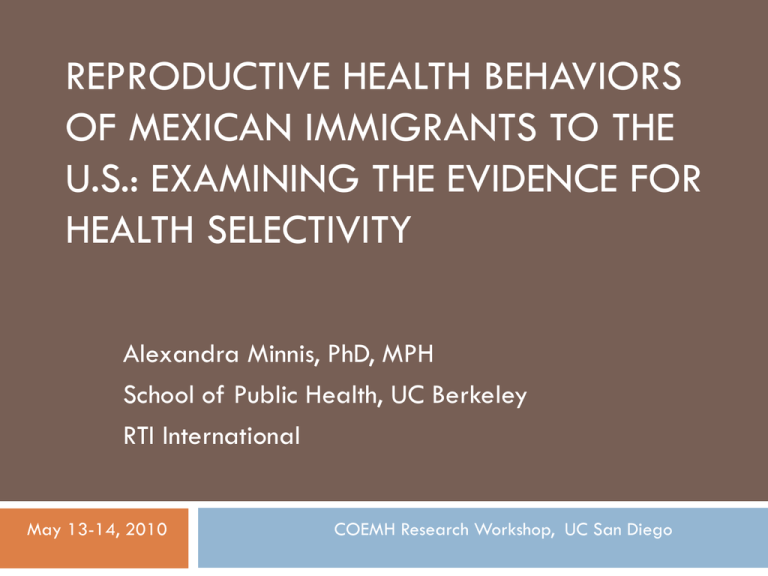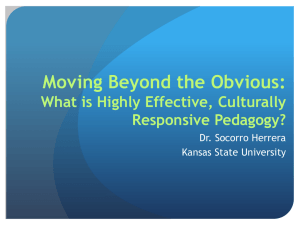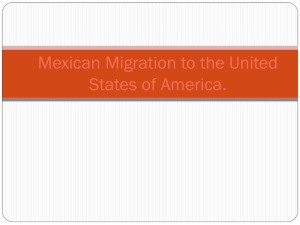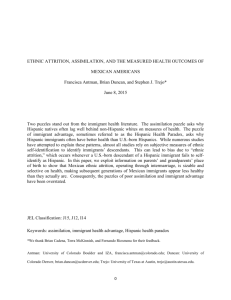
REPRODUCTIVE HEALTH BEHAVIORS
OF MEXICAN IMMIGRANTS TO THE
U.S.: EXAMINING THE EVIDENCE FOR
HEALTH SELECTIVITY
Alexandra Minnis, PhD, MPH
School of Public Health, UC Berkeley
RTI International
May 13-14, 2010
COEMH Research Workshop, UC San Diego
Mexico-U.S. Migration & Reproductive
Health Patterns are Complex
Immigration from Mexico to U.S. associated with
increased reproductive health vulnerability.
Higher fertility seen among immigrant women
relative to U.S.-born.
Immigrant women typically report lower risk sexual
behaviors than U.S.-born counterparts.
“Hispanic
Paradox”
Immigrant Adaptation
Partner gang membership/incarceration
% Yes
OR1
Recent immigrant
17.2
-
1.5 generation
32.9
2.3
(1.1, 5.2)
2nd generation
42.7
3.4
(1.8, 6.5)
3rd generation
49.7
5.5
(2.7, 11.1)
U.S. Generation
1Adjusted
for age, gender, familism, and parental monitoring.
95% CI
Health Selectivity
Individuals who migrate to the U.S. may exhibit
healthier behaviors than non-migrants.
Limitations in work to date:
Cross-sectional
analyses.
Small, non-representative studies.
Behavioral/health assessment after migration.
Research Aim
To determine whether health selectivity contributes
to reproductive health patterns observed among
immigrant Mexican women in the U.S.
Contraceptive
practices
Sexual risk behaviors
Design
Study data derived from 2 nationally
representative surveys:
Mexico
Family Life Survey (MxFLS): 2002 & 2005
National Survey of Family Growth (NSFG): 2002
Analytic samples
MxFLS:
Women aged 15-49; no history of U.S.
migration in 2002; location known in 2005. N=8,732.
NSFG: Women aged 15-44; Mexican immigrant or
U.S.-born of Mexican descent. N=921 of 7,643 total.
Measures and Analysis
Measures
Exposure: U.S. migration.
Outcomes:
Contraceptive practices: lifetime & current use.
Sexual risk behaviors: lifetime number of sexual partners; early
onset of sexual activity (< 15 yrs).
Confounders: multiple sociodemographic factors.
Analysis
Comparison of outcomes across four groups of women:
Mexican non-immigrants
Mexican women who migrated to the U.S. between 2002 & 2005
Mexican immigrants residing in U.S.
U.S.-born women of Mexican descent
MxFLS Sample:
Sociodemographic Background
No U.S.
Migration
U.S. Migration
2002 to 2005
%
%
Mean age (in years)**
29.4
24.3
Married (ever)*
57.6
35.4
Very high
2.9
2.1
High
9.2
22.7
Medium
13.9
23.4
Low
16.3
24.0
Very low
57.7
27.8
Mean parity**
1.9
1.2
Intends to have
additional children**
54.2
71.9
Marginalization index*
*p<0.01; **p<0.001.
NSFG Sample:
Sociodemographic Background
Mexican
Immigrant
U.S.-born of
Mexican Descent
%
%
Mean age (in years)*
30.4
26.7
Married (ever)**
68.1
48.0
< high school
55.0
9.9
some high school
12.3
22.6
high school
14.2
25.2
some college
13.5
31.8
college graduate
5.1
10.6
Mean parity**
2.0
1.3
Intends to have
additional children
51.5
52.9
Educational Attainment**
*p<0.01; **p<0.001.
Reproductive Health Behaviors
Mexico Family Life Survey
No U.S. Migrated to U.S.
Migration
2002-05
Contraceptive use
National Survey of Family Growth
Mexican
Immigrants
U.S.-born of
Mexican Descent
%
%
%
%
Hormonal
8.5
7.5
26.3
23.0
Condoms
5.9
2.4
14.4
12.3
Permanent
41.6
40.7
30.6
26.1
Natural
5.0
0.9
4.3
5.1
Nothing used
39.0
48.5
24.4
33.5
Vaginal sex ever
69.5
47.5*
91.9
80.1*
Sexual onset
<=15 yrs
14.5
15.3
15.1
32.7*
Mean lifetime no.
partners
1.3
1.4
2.2
5.3*
*p<0.001.
Summary & Conclusions
No evidence that reproductive health behaviors
varied between immigrant and non-immigrant
women.
Strengths and Limitations:
Population-based
prospective survey data.
Measures limited in scope.
Focus attention on recent immigrants’ reproductive
health needs and on factors affecting adaptation
trajectories.












